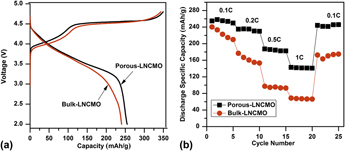Crossref Citations
This article has been cited by the following publications. This list is generated based on data provided by
Crossref.
Bao, Jie
Wu, Dihua
Tang, Qing
Ma, Zhinan
and
Zhou, Zhen
2014.
First-principles investigations on delithiation of Li4NiTeO6.
Physical Chemistry Chemical Physics,
Vol. 16,
Issue. 30,
p.
16145.
Rao Penki, Tirupathi
Shanmughasundaram, D.
Jeyaseelan, A. V.
Subramani, A. K.
and
Munichandraiah, N.
2014.
Polymer Template Assisted Synthesis of Porous Li1.2Mn0.53Ni0.13Co0.13O2as a High Capacity and High Rate Capability Positive Electrode Material.
Journal of The Electrochemical Society,
Vol. 161,
Issue. 1,
p.
A33.
Penki, Tirupathi Rao
Shanmughasundaram, D.
Kishore, Brij
Jeyaseelan, A. V.
Subramani, A. K.
and
Munichandraiah, N.
2016.
Composite of Li-Rich Mn, Ni and Fe Oxides as Positive Electrode Materials for Li-Ion Battery.
Journal of The Electrochemical Society,
Vol. 163,
Issue. 8,
p.
A1493.
Liang, Xing
Gao, Guohua
Wu, Guangming
and
Yang, Huiyu
2016.
Synthesis and characterization of novel hierarchical starfish-like vanadium oxide and their electrochemical performance.
Electrochimica Acta,
Vol. 188,
Issue. ,
p.
625.
Schipper, Florian
Nayak, Prasant
Erickson, Evan
Amalraj, S.
Srur-Lavi, Onit
Penki, Tirupathi
Talianker, Michael
Grinblat, Judith
Sclar, Hadar
Breuer, Ortal
Julien, Christian
Munichandraiah, Nookala
Kovacheva, Daniela
Dixit, Mudit
Major, Dan
Markovsky, Boris
and
Aurbach, Doron
2017.
Study of Cathode Materials for Lithium-Ion Batteries: Recent Progress and New Challenges.
Inorganics,
Vol. 5,
Issue. 2,
p.
32.
Yu, Bing
Cong, Hailin
Yang, Zhen
Yang, Shujing
Wang, Yuezhong
Zhai, Feng
and
Wang, Yifan
2017.
Preparation of Humidity-Sensitive Poly(Ethylene Glycol) Inverse Opal Micropatterns Using Colloidal Lithography.
Materials,
Vol. 10,
Issue. 9,
p.
1035.
Li, Xiang
Qiao, Yu
Guo, Shaohua
Xu, Zhenming
Zhu, Hong
Zhang, Xiaoyu
Yuan, Yang
He, Ping
Ishida, Masayoshi
and
Zhou, Haoshen
2018.
Direct Visualization of the Reversible O2−/O− Redox Process in Li‐Rich Cathode Materials.
Advanced Materials,
Vol. 30,
Issue. 14,
Gan, Zhanggen
Lu, Yan
Hu, Guorong
Peng, Zhongdong
Du, Ke
Wang, Weigang
Li, Tianfan
Tao, Yong
and
Cao, Yanbing
2019.
Surface modification on enhancing the high-voltage performance of LiNi0.8Co0.1Mn0.1O2 cathode materials by electrochemically active LiVPO4F hybrid.
Electrochimica Acta,
Vol. 324,
Issue. ,
p.
134807.
